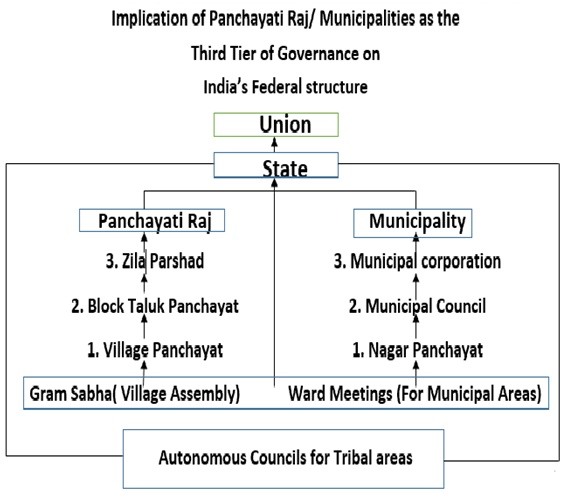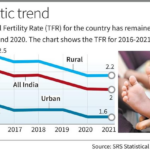Understanding Grassroots Governance: The Micropicture at the Panchayat Level
Relevance: GS Paper 2 (Governance, Constitution, and Polity) in the UPSC syllabus
The release of the Panchayat Advancement Index (PAI) Baseline Report 2022-23 in April 2025 marks a major milestone in India’s grassroots governance and data-driven policymaking.
Recently, the Ministry of Panchayati Raj launched (PAI), Panchayat Advancement Index (PAIBaseline Report 2022-23), which represents a speech change. For the first time, more than 2,16 Lakh Gram Panchayats have been evaluated using 566 data points in line with the location of sustainable development goals (LSDGS) in India.

- India’s vision for decentralised governance has constantly fought with contradiction: While Gram Panchayats (GP) act as the first line of democratic administration for the countryside, they have largely operated in a computer-based system.
- Politics is often designed from above, informed by the “macrolinsen” that glows on complex and highly localised challenges on the ground.

Panchayati Raj Institution
The 73rd Constitutional Amendment Act, 1992, also known as the Panchayati Raj Act, is a landmark legislation in India that aims to provide a three-tier system of decentralised self-governance in rural areas. The main provisions of the Act are outlined in Part IX of the Indian Constitution, which consists of Articles 243 to 243-O
Provisions of the 73rd Constitutional Amendment Act, 1992 :
- Three-tier system: Establishing a three-tier system of panchayats (local self-governments) in rural areas, comprising the gram panchayat (village council), panchayat samiti (block council), and Zilla parishad (district council).
- Population: Providing for the establishment of a panchayat at the village level for every village having a population of at least 500 persons.
- Elections: Mandating regular elections to panchayats and the conduct of elections following the provisions of the Act and the rules made thereunder.
- Reservation: Providing for the reservation of seats for scheduled castes, scheduled tribes, and women in panchayats at all levels, as well as the reservation of the office of the chairpersons of panchayats at the village and intermediate levels for Scheduled Castes, Scheduled Tribes, and women.
- State Finance Commission: Providing for the constitution of finance commissions to review the financial position of panchayats and to make recommendations for the devolution of funds, grants-in-aid, and taxes to panchayats.
- Power and Functions: Providing for the powers, authority, and responsibilities of panchayats, including the preparation of plans for economic development and social justice and the implementation of schemes for the development of agriculture, cottage and small-scale industries, education, health, and other sectors.
Evidence-based policy and its limitations
Making evidence -based decisions has become a catch in the control circuits. However, the practical reality of India is inconsistent. Bureaucracy decisions often rely more on intuition and administrative experience than hard data.
Reasons for this disconnection:
- Delayed or inaccessible census data: Census in 2021. Delays and concerns about the changed function of national surveys have affected the continuity and reliability of time series data.
- Heavy and bad fantasy data: Government portals such as Data.gov.in House Huge amounts of information. However, this data is often difficult to interpret, even for researchers, let local representatives or citizens go alone.
- Top-down data architecture: Most computer systems are designed for state and national bureaucracy, not for local governance structures. This means that ground -level actors often lack analytical equipment required for local planning and execution.
- Panchayat Advancement Index (PAI) is a revolutionary effort for the democratisation of ground-level data. It focuses on hyperlocal development indicators from macroeconomic calculations, which allows fine tracking of performance at the level of the Gram Panchayat.
- Main features: 2.16 Lakh Gram Panchayats, with 435 unique indicators.
- Structure: 331 Mandatory and 104 Alternative indicators spread over nine LSDG subjects, alliances with the national indicator infrastructure (NIF).
- Availability: Portal (pai.gov.in). A simple constituency report allows for generations.
- Data is not just input-based. It is associated with real consequences, so that stakeholders can monitor real improvements in areas such as health, education and infrastructure. Simple constituency report allows for generations.
Mega to Micro: Democratization data
- The main performance of pie is its axis, which ranges from total “megadata” to a useful “micropike” at the Panchayat level. It also includes:
- Transparent data at home: When presented in simple, visual formats, individual families can also understand what their panchayat price is.
- Action-oriented target card: Pie does not stop at the diagnosis. This suggests treatment and provides a roadmap for adjusted improvement with LSDG.
Challenges in the implementation
- Problems with computerisation: Conditions that Uttar Pradesh presented data for only 23,207 of its 57,702 GPs. Such intervals are in the use of a nationwide index and raise concerns about data integrity.
- Lack of analytical capacity locally: While data is available, most GPs lack trained personnel to explain and act on it. Educated data analysts are required to be distributed at the block and district levels.
- Technology interval: Poor internet connection, older computers and low digital reading skills still bother many rural offices.
- Political desire: A good working cake system can highlight the unpleasant truth. The success depends on political leaders that they are ready to work with these disclosures, rather than suppressing them.
Financing and policy integration
- Corporate Social Responsibility (CSR)
- District Mineral Foundation (DMF) Grant
- Member of Parliament Local Area Development (MPLADS)and MLALADS (Members of Legislative Assembly Local Area Development Scheme)
- Under the scheme annual MPLADS fund entitlement per MP constituency is Rs. 5 crore.
- Lok Sabha Members can recommend works within their Constituencies.
- The Rajya Sabha Members of Parliament can recommend works in one or more districts in the State from where he/she has been elected.
- The Nominated Members of the Lok Sabha and Rajya Sabha may select any one or more Districts from any one State in the Country for implementation of their choice of work under the scheme.
- MPs are to recommend every year, works costing at least 15 per cent of the MPLADS entitlement for the year for areas inhabited by Scheduled Caste population and 7.5 per cent for areas inhabited by S.T. population.
- In case an elected MP wishes to contribute MPLADS funds outside the constituency or the State/UT, they can recommend work up to Rs 25 lakh in a financial year.
- MPs do not directly receive funds under MPLADS. The Centre directly transfers the sanctioned amount in two installments of Rs. 2.5 crore to the district authorities of the concerned MP’s nodal district after a recommended project gets approval.
Way Forward
- Capacity building: Training programs for local authorities, especially data analysts, should be given institutional form.
- Regular reporting: PAI should not exercise a time at a time. Continuous updates and public dashboards are required.
- Public awareness campaign: The more people know about the score for Panchayat, the more pressure it is for improvement.
- Urban Adaptation: A similar index for urban local bodies will be developed to track and promote municipal governance.
- Integration with the scheme: Local development plans (LDP) must be informed by PAI findings.
Conclusion
Panchayat Advancement Index is more than just one dashboard; This is a clear call for democratic decentralisation in a harder sense. By distributing “microproprikk” in a digestible, actionable form, it enables India’s 2.5 million grams of panchayats to graduate from passive implementation of schemes to active planners and evaluators of development.
PRELIMS PRACTICE QUESTION
Question: About the Panchayat Advancement Index (PAI) recently launched by the Ministry of Panchayati Raj, consider the following statements:
- The PAI is a dynamic index that uses real-time satellite data integrated with biometric attendance of frontline workers to assess the gram panchayat’s performance.
- The Index evaluates gram panchayats using more than 500 data points across themes aligned with the National Indicator Framework (NIF).
- The PAI allows Members of Parliament and Members of Legislative Assemblies to generate constituency-wise reports to plan interventions aligned with LSDGs.
- All states and union territories submitted 100% validated data for their gram panchayats under the PAI Baseline Report 2022–23.
Which of the statements given above is/are correct?
A. 2 and 3 only
B. 1, 2 and 4 only
C. 1 and 4 only
D. 3 and 4 only
Answer: A. 2 and 3 only
Explanation:
- Statement 1: Incorrect. The PAI does not yet use real-time satellite or biometric data. It is based on collected and validated indicators across themes, but not through advanced technology like satellite integration.
Statement 2: Correct. The Index is based on 566 data points across nine LSDG themes and aligned with the National Indicator Framework. - Statement 3: Correct. The PAI portal (pai.gov.in) enables constituency-wise report generation, allowing MPs and MLAs to plan development interventions.
Statement 4: Incorrect. Not all states submitted complete data. For example, Uttar Pradesh submitted data for only 40% of its gram panchayats.
MAINS PRACTICE QUESTION
Question: “The Panchayat Advancement Index (PAI) marks a paradigm shift from abstract macroeconomic governance to grounded, data-driven micro-level planning. Critically examine how the PAI attempts to democratise evidence-based policy-making at the grassroots, while also analysing the structural, technical, and political constraints that may limit its transformative potential. Suggest institutional and systemic reforms to ensure that the PAI becomes a cornerstone of decentralised development planning in India.”







